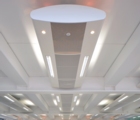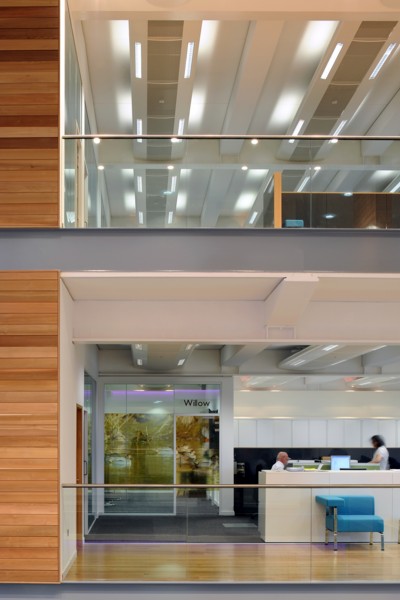The energy-efficiency capabilities of chilled beams to cut carbon

Delivering more comfort using less energy is the key to reducing carbon emissions from buildings. David Leatherbarrow reviews how chilled ceilings and beams can do just this.
There is a scientific consensus that we must find a way to limit man-made climate change by reducing carbon emissions. One way of achieving this is to reduce the amount of energy used in cooling, heating and lighting buildings, which accounts for about half of the UK's carbon dioxide emissions. Moreover, unlike many other sources of carbon emissions, the technology already exists to dramatically reduce building energy consumption — even before renewable energy is considered.
Chilled beams and chilled ceilings provide an energy-efficient, quiet and comfortable option. They are based on proven technology and can cost up to 30% less than other approaches.
There are four main products available.
First are chilled ceilings constructed from a copper cooling element bonded to the back of a metal ceiling tile. They work by radiating cooling energy downwards. Their compact design allows ceilings to be installed in voids as small as 100 mm, which makes them ideal for refurbishments. Their flush finish also makes it easy to reconfigure partitioning systems without the need to disturb the ceiling.
Second are passive chilled beams, which also have a copper cooling element, usually with aluminium fins bonded to it. Chilled beams use convection to deliver cooling. Perforated tiles allow warm air to rise from the occupied space to the chilled beams at ceiling level, where it is cooled so that it descends naturally.
Third are active chilled beams, which are similar to passive units but with the addition of tempered air supplied through induction nozzles to provide ventilation. The induced airflow increases the amount of air passing over the coil, increasing the beam’s cooling capacity. Because they rely on powered air movement, active beams can also deliver heat to a space.
Fourth are integrated service modules, or multi-service chilled beams as they are sometime known, which feature an architecturally designed metal casing. This casing incorporates a chilled beam (either active or passive), along with luminaires and other building services. The units are generally suspended from a soffit, which can remain exposed to allow its thermal mass to be exploited.
A chilled beam’s energy efficiency comes from its ability to recirculate air within a space, since only sufficient fresh air is provided to meet occupancy requirements. As a result, fewer air changes are needed, so ductwork and air-handling units can be smaller. Exhaust fans and chillers can be downsized too, or run at a lower speed to reduce emissions and costs.

Like all traditional systems, chilled beams are supplied with cooling from a central chiller unit. Water is pumped through a circuit from the chiller to the chilled beam, where it removes heat from the space, before returning to the chiller. Unlike traditional systems, however, chilled beams use a higher chilled-water temperature at 14 to 17°C, so chillers can be operated more efficiently by taking advantage of free-cooling options for much of the year.
In addition, high chilled-water temperatures provide the option of using ground water for cooling for much of the year. This can lessen the need for large refrigeration systems, which again reduces both cooling energy consumption and the size of cooling plant.
SAS International integrated service modules (ISMs) fitted with passive chilled beams have been installed at the newly built operations centre for Essex & Suffolk Water. FaulknerBrowns architects, Hoare Lea and SAS Project Management worked closely to provide a building with an ‘Excellent’ BREEAM environmental rating. The 3-storey building incorporates a range of innovative sustainable features, including a water source heat pump using water from the nearby Hanningfield reservoir to provide heating and cooling throughout the building. Working with the client and the water-treatment team, the design team has been able to use reservoir water to help cool and heat the building, resulting in substantial savings in running costs and demonstrating Essex & Suffolk Water's commitment to the environment.
In addition to energy savings, maintenance costs too tend to be lower for chilled-beam systems because they contain few moving parts.
As with any technology, chilled beams and ceilings have their limitations. Under some conditions, the fresh-air supply will need to be dehumidified to ensure beams remain free of condensation, but this cost is minimal in the context of the benefits a chilled-beam system will bring to a scheme.
Minor limitations aside, in the current economic climate it is important to remember that chilled beams can be a quiet, low-energy choice for both new and refurbishment projects. What is more, chilled beams made from copper, steel and aluminium can easily be recycled at the end of their life, saving further energy and resources.
David Leatherbarrow is with SAS International.







